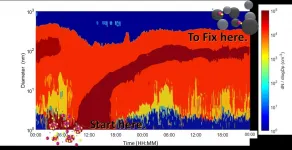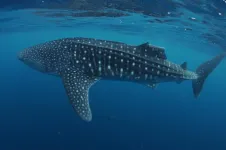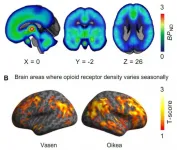Largest comprehensive Middle East GWAS reveals Arab genetic risk factors
QATAR GENOME RESEARCH CONSORTIUM investigators identify genetic associations with 45 clinically relevant traits in the Qatari population
2021-02-23
(Press-News.org) Doha, Qatar - (February 23, 2021) - A group of researchers at Qatar Foundation have reported the first and largest genetic association study in the Middle East, that has been published online in Nature Communications - a leading a peer-reviewed, open access, scientific journal published by Nature Research.
The study titled "Whole genome sequencing in the Middle Eastern Qatari population identifies genetic associations with 45 clinically relevant traits" highlights a vital piece of information wherein now there is a better understanding of the genetic risk factors that are specific to the Arab population, including those that are shared with other ethnicities.
Qatar was among the first countries to launch its own large-scale, national genome project. Qatar Genome combines whole genome sequencing data with comprehensive phenotypic resource collected at Qatar Biobank, and is considered the first, largest and most ambitious population-based projects of its kind in the Middle East.
This kind of studies can be considered as experiments conducted by nature, where the natural variation found in the genomes of thousands of Qataris is linked to variations in their respective blood tests. The results from this project are shared publicly, ensuring that the specificities of the Arab genomes will be taken into consideration in future research on new treatments and therapies.
The study - led by researchers at Qatar Foundation's (QF's) Hamad Bin Khalifa University (HBKU) and QF's partner university Weill Cornell Medicine - Qatar (WCM-Q), along with other scientists from the Qatar Genome Research Consortium - includes over 6,000 Qatari individuals with whole genome sequence data.
By performing detailed assessments of genetic variants across the whole genome in 6,218 individuals, comprising data from 45 clinically relevant traits, this study identified about 300 independent genetic signals. Some of these signals were predominantly found in the Qatari population. This observation was then confirmed in a further 7,768 subjects from QF's Qatar Biobank.
Omar Albagha, Principal Investigator from HBKU's College of Health and Life Sciences, says: "The study provides new insights into the genetic architecture of clinical laboratory tests and identifies for the first time genetic variations that are specific to the population of Qatar. The study also shows that findings from genetic studies in European populations don't translate well when applied to our population in the Middle East. This argues for further studies to define the genetic architecture of diseases in our region. We are excited because the study represents a foundation for the implementation of precision medicine in the Middle East."
Karsten Suhre, Director of Bioinformatics Core at Weill Cornell Medicine - Qatar and joint senior author on the paper, says: "It has been a long but successful journey from the first patient recruitments to Qatar Biobank to analyzing the resulting enormous genetic data set for associations with clinically relevant traits, and we as a consortium are proud to contribute with this paper to the international effort of obtaining an even better understanding of our human genome."
"Qatar Genome Research Consortium gave research groups the platform to study whole genome sequencing and other omics data to empower the genetic discoveries in this part of the world, which otherwise would be under-represented," said Professor Said Ismail, Director of QF's Qatar Genome, part of QF Research, Development, and Innovation.
INFORMATION:
Reference:
Thareja G, Al-Sarraj Y, Belkadi A, Almotawa M, the Qatar Genome Program Research (QGPRC) Consortium, Suhre K, Albagha O.M.E. "Whole genome sequencing in the Middle Eastern Qatari population identifies genetic associations with 45 clinically relevant traits" Nature Communications 2021 https://doi.org/10.1038/s41467-021-21381-3
About Qatar Genome Program
Qatar Genome Program (QGP) is the largest genome project in the Middle East with a mission to promote genomic research and clinical implementation at a national level. QGP is designed around a comprehensive strategy involving large scale genome sequencing and multi-omics data, establishing local and international research partnerships, building local human capacity, facilitating integration into the healthcare system, drafting guidelines and policies, raising public awareness as well as empowering and educating patients.
About Qatar Biobank
Qatar Biobank is a medical research center performing vital health research through its collection of samples and information on health and lifestyle of the Qatari population.
Qatar Biobank was created in collaboration with Hamad Medical Corporation and the Ministry of Public Health to enable local scientists to conduct medical research on prevalent health issues in Qatar.
Qatar Genome and Qatar Biobank are both Research, Development & Innovation entities within Qatar Foundation for Education, Science and Community Development.
About Hamad Bin Khalifa University
Innovating Today, Shaping Tomorrow
Hamad Bin Khalifa University (HBKU), a member of Qatar Foundation for Education, Science, and Community Development (QF), was founded in 2010 as a research-intensive university that acts as a catalyst for transformative change in Qatar and the region while having global impact. Located in Education City, HBKU is committed to building and cultivating human capacity through an enriching academic experience, innovative ecosystem, and unique partnerships. HBKU delivers multidisciplinary undergraduate and graduate programs through its colleges, and provides opportunities for research and scholarship through its institutes and centers. For more information about HBKU, visit http://www.hbku.edu.qa.
About Weill Cornell Medicine-Qatar
Weill Cornell Medicine - Qatar is a partnership between Cornell University and Qatar Foundation. It offers a comprehensive six-year medical program leading to the Cornell University M.D. degree with teaching by Cornell and Weill Cornell faculty and by physicians at Hamad Medical Corporation (HMC), Aspetar Orthopedic and Sports Medicine Hospital, the Primary Health Care Corporation, the Feto Maternal Center, and Sidra Medicine, who hold Weill Cornell appointments. Through its biomedical research program, WCM-Q is building a sustainable research community in Qatar while advancing basic science and clinical research. Through its medical college, WCM-Q seeks to provide the finest education possible for medical students, to improve health care both now and for future generations, and to provide high quality health care to the Qatari population.
Qatar Foundation - Unlocking Human Potential
Qatar Foundation for Education, Science and Community Development (QF) is a non-profit organization that supports Qatar on its journey to becoming a diversified and sustainable economy. QF strives to serve the people of Qatar and beyond by providing specialized programs across its innovation-focused ecosystem of education, research and development, and community development.
QF was founded in 1995 by His Highness Sheikh Hamad bin Khalifa Al Thani, the Father Amir, and Her Highness Sheikha Moza bint Nasser, who shared the vision to provide Qatar with quality education. Today, QF's world-class education system offers lifelong learning opportunities to community members as young as six months through to doctoral level, enabling graduates to thrive in a global environment and contribute to the nation's development.
QF is also creating a multidisciplinary innovation hub in Qatar, where homegrown researchers are working to address local and global challenges. By promoting a culture of lifelong learning and fostering social engagement through programs that embody Qatari culture, QF is committed to empowering the local community and contributing to a better world for all.
For a complete list of QF's initiatives and projects, please visit: http://www.qf.org.qa
For any media inquiries, please contact: pressoffice@qf.org.qa
[Attachments] See images for this press release:

ELSE PRESS RELEASES FROM THIS DATE:
2021-02-23
A recent genetic study at the University of Helsinki provides new information on the occurrence of a DVL2 gene defect associated with a screw tail and its relevance to canine constitution and health. The variant was found in several Bulldog and Pit Bull type breeds, and it was shown to result in caudal vertebral anomalies and shortening of the muzzle. The DLV2 variant may also affect the development of the heart.
Dog breeding is often focused on appearance. In some breeds, the ideal body shape is bulky, with a broad head and short muzzle, short legs and a very short and kinked tail, also known as a "screw tail". In a previous study in the United States, screw tail was linked to a variant in the DVL2 gene. The variant has become enriched ...
2021-02-23
According to recent estimates, there will be roughly 10 billion people to feed in 2050. Agricultural production will need to increase by almost 56% to guarantee food security globally, without converting more land for agriculture (in line with environmental and climate targets). This unprecedented challenge has ushered in the era of "smart agriculture," which promises to revolutionize food production by combining agricultural techniques with information technology, automation, and artificial intelligence. This new era, called "Agriculture 4.0," could ensure sustainable food production for the entire world. However, as communities gradually embrace smart agriculture, it is important to understand how to manage the security and privacy risks associated with the integration of ...
2021-02-23
Washington, DC / New Delhi, India - Researchers at CDDEP, in collaboration with leading experts in the field, have produced the "Infectious Diseases in the South-East Asia Region" report, which examines cross-boundary challenges in communicable disease control in countries in the South-and South-East Asia region. The report emphasizes infectious diseases related to other sources of disease burden in the region and communicates overall trends in the health and economic burden they impose.
Despite substantial progress in recent years, which has seen reductions in deaths from HIV and malaria and an increase ...
2021-02-23
Researchers of the University of Helsinki have resolved for the first time, how the ultrafine particles of atmosphere effect on the climate and health.
Atmospheric air pollution kills more than 10,000 people every day. The biggest threat to human health has been assumed to be the mass accumulation of atmospheric particles with diameter smaller 2.5 μm: the higher the mass and loss of visibility, the bigger the threat.
The researchers of the Institute for Atmospheric and Earth System Research (INAR) at the University of Helsinki together with collaborators in China discovered that if we want to solve the accumulation of the biggest particles, we need to start with the smallest.
Until recent ...
2021-02-23
A new study has for the first time explored the rate at which the world's largest fish, the endangered whale shark, can recover from its injuries. The findings reveal that lacerations and abrasions, increasingly caused through collisions with boats, can heal in a matter of weeks and researchers found evidence of partially removed dorsal fins re-growing.
This work, published in the journal Conservation Physiology, comes at a critical time for these large sharks, that can reach lengths of up to 18 metres. Other recent studies have shown that as their popularity within the wildlife tourism sector increases, so do interactions with humans and boat traffic. As a result, these ...
2021-02-23
Huntington's disease is caused by a mutation in the Huntingtin gene (HTT), which appears in adults and features motor, cognitive and psychiatric alterations. The origin of this disease has been associated with the anomalous functioning of the mutated protein: mHTT, but recent data showed the involvement of other molecular mechanisms.
A new study conducted by the University of Barcelona has identified a type of ribonucleic acid (RNA) as a potential therapeutic target for the treatment of the disease. These are the small RNA, or sRNAs, molecules that do not code proteins but have important functions in the regulation of gene expression. According to the study, sRNAs would ...
2021-02-23
X-ray scans revolutionised medical treatments by allowing us to see inside humans without surgery. Similarly, terahertz spectroscopy penetrates graphene films allowing scientists to make detailed maps of their electrical quality, without damaging or contaminating the material. The Graphene Flagship brought together researchers from academia and industry to develop and mature this analytical technique, and now a novel measurement tool for graphene characterisation is ready.
The effort was possible thanks to the collaborative environment enabled by the Graphene Flagship European consortium, with participation by scientists from Graphene Flagship partners DTU, Denmark, IIT, Italy, Aalto University, Finland, AIXTRON, UK, imec, Belgium, Graphenea, Spain, Warsaw ...
2021-02-23
Seasons have an impact on our emotions and social life. Negative emotions are more subdued in the summer, whereas seasonal affective disorder rates peak during the darker winter months. Opioids regulate both mood and sociability in the brain.
In the study conducted at the Turku PET Centre, Finland, researchers compared how the length of daylight hours affected the opioid receptors in humans and rats.
"In the study, we observed that the number of opioid receptors was dependent on the time of the year the brain was imaged. The changes were most prominent in the brain regions that control emotions and sociability. The changes in the opioid receptors caused by the variation in the amount of daylight could be an important factor in seasonal affective disorder," ...
2021-02-23
WASHINGTON -- Researchers have developed a new sensor that could allow practical and low-cost detection of low concentrations of methane gas. Measuring methane emissions and leaks is important to a variety of industries because the gas contributes to global warming and air pollution.
"Agricultural and waste industries emit significant amounts of methane," said Mark Zondlo, leader of the Princeton University research team that developed the sensor. "Detecting methane leaks is also critical to the oil and gas industry for both environmental and economic reasons because natural gas is mainly composed of methane."
In ...
2021-02-23
A new study suggests that a hormone known to prevent weight gain and normalize metabolism can also help maintain healthy muscles in mice. The findings present new possibilities for treating muscle-wasting conditions associated with age, obesity or cancer, according to scientists from the University of Southern California Leonard Davis School of Gerontology.
The research, published this month in the American Journal of Physiology-Endocrinology and Metabolism, addresses the related problems of age and obesity-induced muscle loss, conditions which can lead to increased risk of falls, diabetes and other negative health impacts. It also adds to a growing number of findings describing beneficial effects of MOTS-c, ...
LAST 30 PRESS RELEASES:
[Press-News.org] Largest comprehensive Middle East GWAS reveals Arab genetic risk factors
QATAR GENOME RESEARCH CONSORTIUM investigators identify genetic associations with 45 clinically relevant traits in the Qatari population







